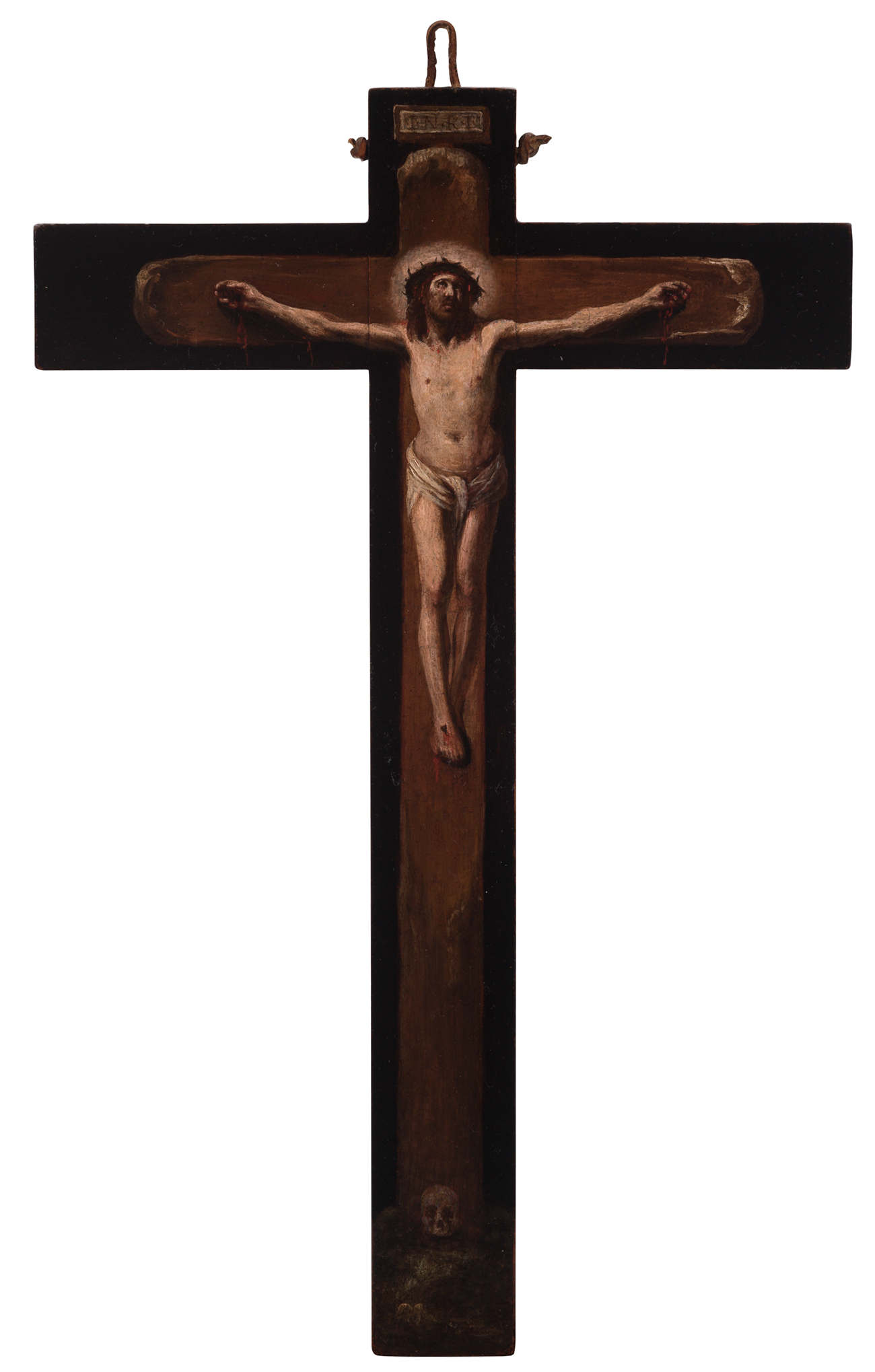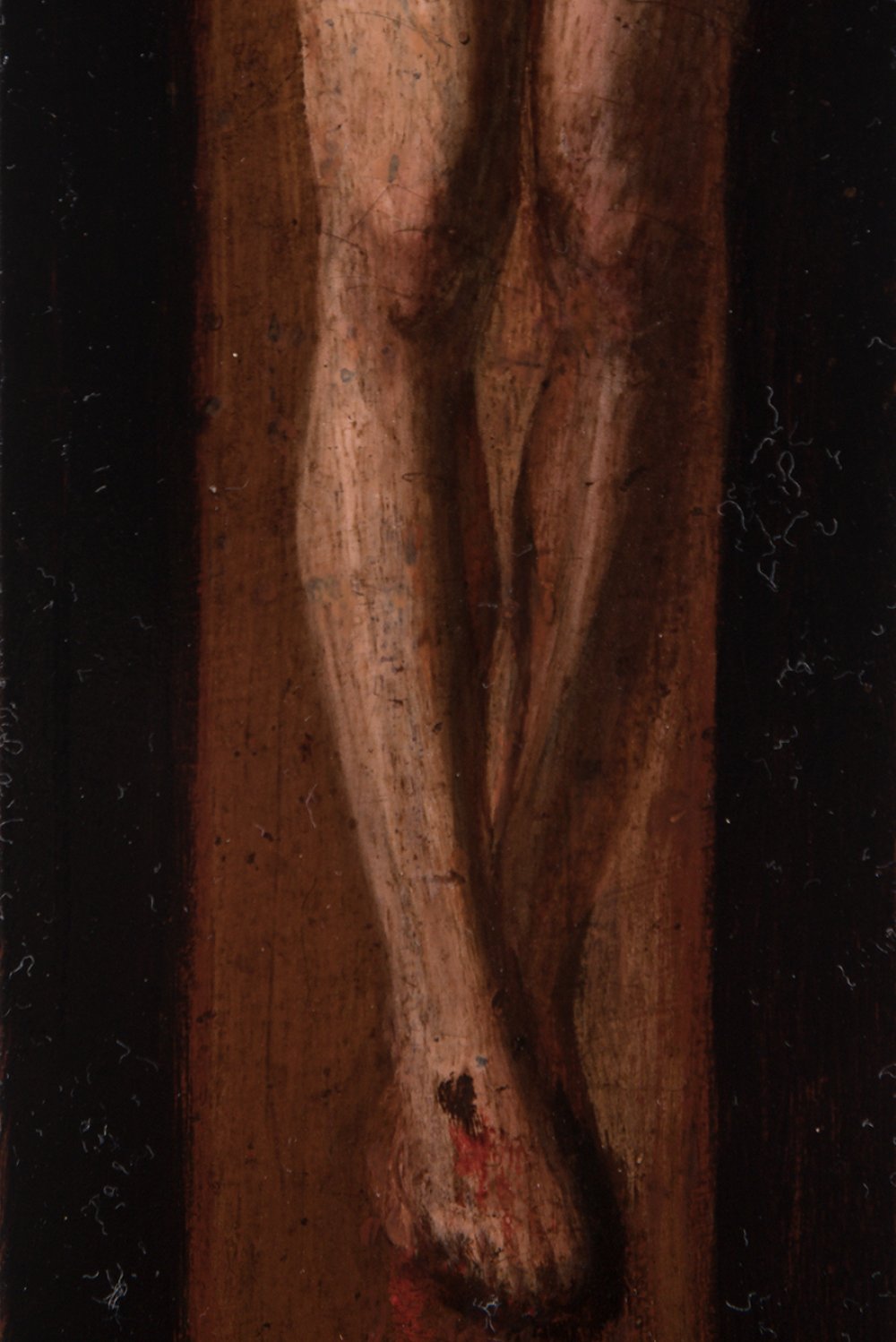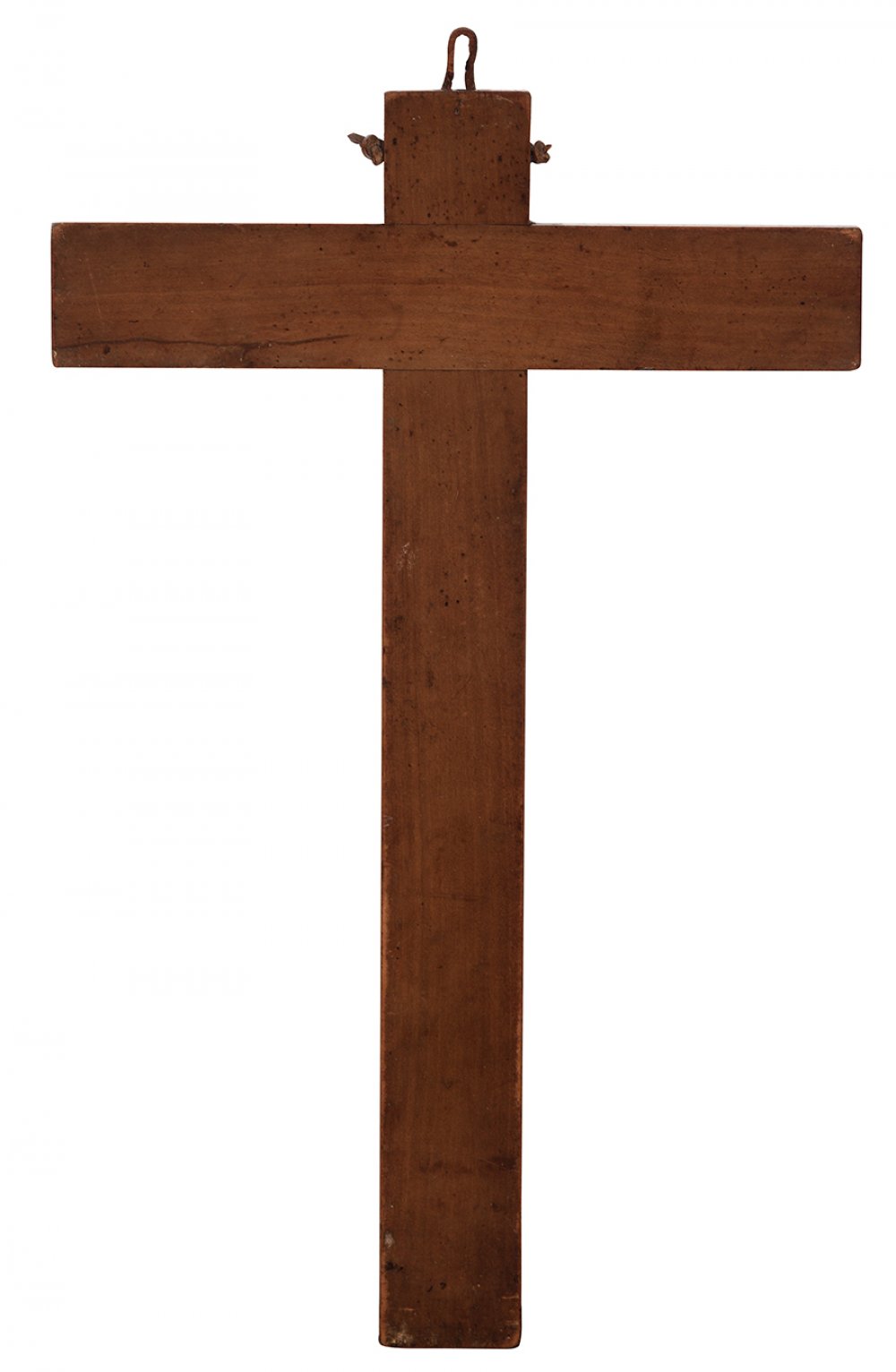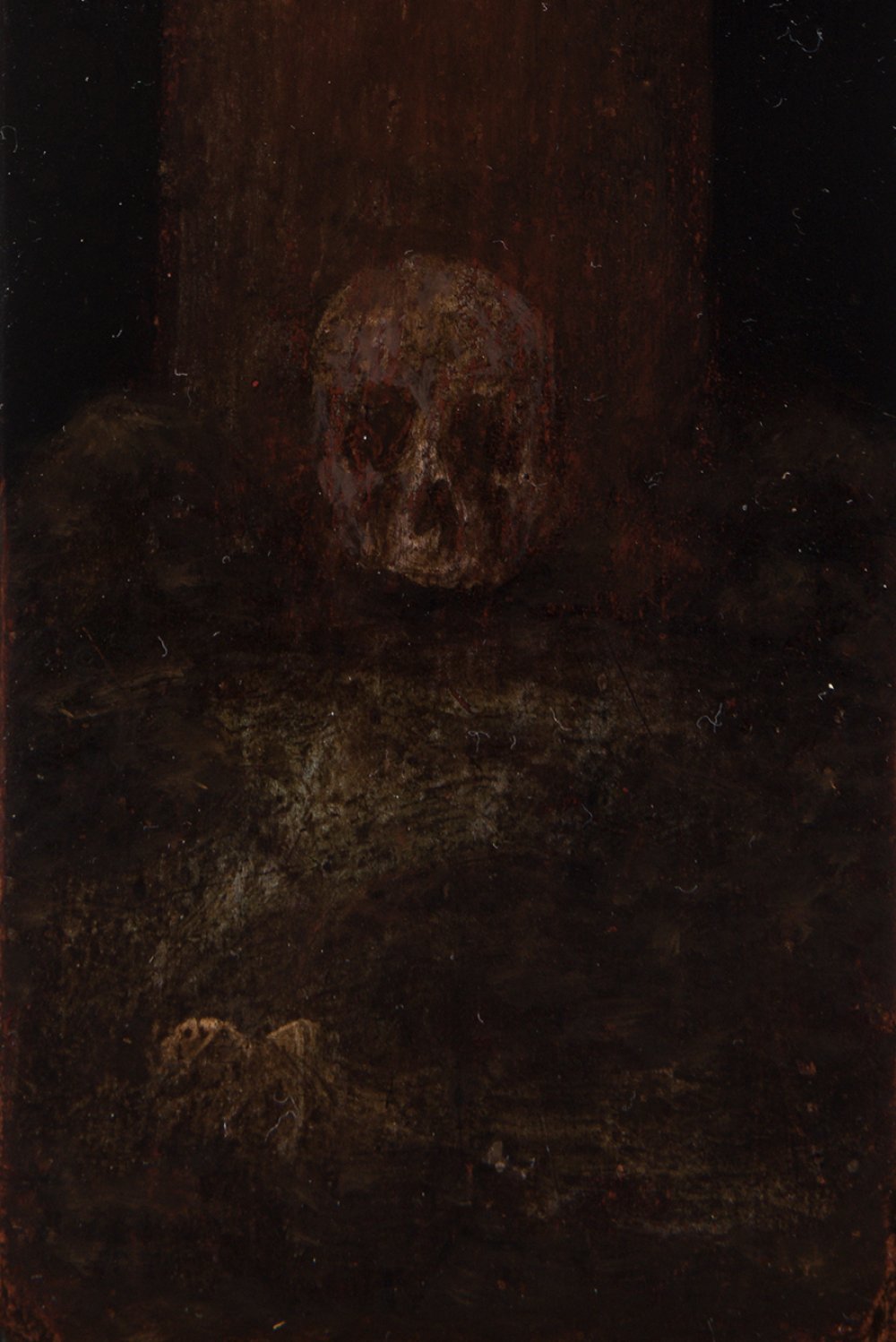9
Spanish school; mid-17th century."Christ crucified".Oil on panel.Measurements: 44 x 28 cm.This
"Christ crucified".
Oil on panel.
Measurements: 44 x 28 cm.
This representation of the Crucified Christ follows the precepts of the cell crosses, of the type that was placed inside the monks' cells. As is usual for this type and time, the cross is of rectilinear sections, unadorned and worked in an illusionist manner, with a typically Baroque painting of tenebrist light and pathetic expression. Christ appears in the centre, with an expressively deformed anatomy that denotes the survival of Mannerism even in the 17th century. The lighting is halfway between Baroque tenebrism and the artificial light of Mannerism, and in any case creates an illusionist play that is very much in keeping with Baroque sensibility. At his feet we see a representation of Adam's skull. Cell crosses are a very common type of devotional work in Spanish and Latin American convents and monasteries in the 17th and 18th centuries. However, it is not common for them to contain the signature of their author, as is the case here.
The crucifixion of Christ is the central theme of Christian iconography and especially of Catholic iconography. Christ was subjected to the suffering that befell slaves who were fugitives or in rebellion, a condemnation that was essentially Roman but of Persian origin. This episode in the life of Christ is the most strictly proven historical fact and is also the main argument for the redemption of Christian doctrine: the blood of God incarnate as man is shed for the redemption of all sins. The representation of the crucifixion has undergone an evolution parallel to the liturgical and theological variations of Catholic doctrine in which we would like to point out three milestones: at first early Christian art omitted the representation of the human figure of Christ and the crucifixion was represented by means of the "Agnus Dei", the mystical lamb carrying the cross of martyrdom. Until the 11th century Christ was represented crucified but alive and triumphant, with his eyes open, in accordance with the Byzantine rite, which did not consider the possibility of the existence of Christ's corpse. Later, under the theological consideration that the death of the Saviour is not due to an organic process but to an act of divine will, Christ is represented, on many occasions, already dead with his eyes closed and his head fallen on his right shoulder, showing the sufferings of the passion, provoking commiseration, as is referred to in Psalm 22 when he says: "My God, my God, why have you forsaken me? (...) a mob of the wicked is near me: they have pierced my hands and my feet (...) they have divided my garments and cast lots for my tunic".
"Christ crucified".
Oil on panel.
Measurements: 44 x 28 cm.
This representation of the Crucified Christ follows the precepts of the cell crosses, of the type that was placed inside the monks' cells. As is usual for this type and time, the cross is of rectilinear sections, unadorned and worked in an illusionist manner, with a typically Baroque painting of tenebrist light and pathetic expression. Christ appears in the centre, with an expressively deformed anatomy that denotes the survival of Mannerism even in the 17th century. The lighting is halfway between Baroque tenebrism and the artificial light of Mannerism, and in any case creates an illusionist play that is very much in keeping with Baroque sensibility. At his feet we see a representation of Adam's skull. Cell crosses are a very common type of devotional work in Spanish and Latin American convents and monasteries in the 17th and 18th centuries. However, it is not common for them to contain the signature of their author, as is the case here.
The crucifixion of Christ is the central theme of Christian iconography and especially of Catholic iconography. Christ was subjected to the suffering that befell slaves who were fugitives or in rebellion, a condemnation that was essentially Roman but of Persian origin. This episode in the life of Christ is the most strictly proven historical fact and is also the main argument for the redemption of Christian doctrine: the blood of God incarnate as man is shed for the redemption of all sins. The representation of the crucifixion has undergone an evolution parallel to the liturgical and theological variations of Catholic doctrine in which we would like to point out three milestones: at first early Christian art omitted the representation of the human figure of Christ and the crucifixion was represented by means of the "Agnus Dei", the mystical lamb carrying the cross of martyrdom. Until the 11th century Christ was represented crucified but alive and triumphant, with his eyes open, in accordance with the Byzantine rite, which did not consider the possibility of the existence of Christ's corpse. Later, under the theological consideration that the death of the Saviour is not due to an organic process but to an act of divine will, Christ is represented, on many occasions, already dead with his eyes closed and his head fallen on his right shoulder, showing the sufferings of the passion, provoking commiseration, as is referred to in Psalm 22 when he says: "My God, my God, why have you forsaken me? (...) a mob of the wicked is near me: they have pierced my hands and my feet (...) they have divided my garments and cast lots for my tunic".
9th March - Old Masters
Sale Date(s)
Venue Address
General delivery information available from the auctioneer
Setdart offers Worldwide shipping
PICK UP IN ROOM: You can come and pick up your lots in our offices (Barcelona, Madrid or Valencia). At the moment of the withdrawal, you will be able to accept the current conditions of the lot by means of a document that you will sign.
YOU CAN SEND ANOTHER PERSON TO PICK UP: This person must present a signed authorization that you can find in our web page by accessing from BUY AT SETDART- LOGISTICS-DOWNLOAD AUTHORIZATION DOCUMENT. You can also send an e-mail with the requested data in AUTHORIZATION DOCUMENT to admin@setdart.com
Important Information
22% buyer´s premium
18% buyer´s premium at www.setdart.com
Terms & Conditions
The maximum period to pay the lots is 7 working days. You can pay either via bank transfer or with credit card through our platform www.setdart.com (we only accept VISA or Mastercard).
BUYER´S PREMIUM: 22% Hammer price + 21% VAT from the buyer´s premium
If your piece has more than 100 years, our Ministry of Culture requires an export certificate in order for the piece to leave the country. Note that if the piece goes inside the EU, there is no cost for the export certificate. If the piece goes outside the EU, there is a cost for the export certificate. You can find more information in our Ministry of Culture website: https://www.culturaydeporte.gob.es/en/cultura/patrimonio/exportacionimportacion/exportacion/tasas.html
INQUIRIES: admin@setdart.com
Setdart guides you through the entire process, from the time of award to the day you receive your lot. Our logistics team will be happy to manage your transport, and will advise you on the best shipping method with professionals from the sector used to handling works of art and jewelry.
WE OFFER WORLDWIDE DOOR TO DOOR SHIPPING
PICK UP IN ROOM: You can come and pick up your lots in our offices. At the moment of the withdrawal, you will be able to accept the current conditions of the lot by means of a document that you will sign.
YOU CAN SEND ANOTHER PERSON TO PICK UP: This person must present a signed authorization that you can find in our web page by accessing from BUY AT SETDART-LOGISTICS-DOWNLOAD AUTHORIZATION DOCUMENT. You can also send an e-mail with the requested data in AUTHORIZATION DOCUMENT to admin@setdart.com
SETDART IS NOT RESPONSIBLE FOR THE STATE OF THE PARTS ONCE THEY LEAVE OUR FACILITIES. MRW SHIPMENTS: Once the payment is made, your lot will be packed for shipment, the logistics department will send you an e-mail notifying you of the day it leaves our warehouse, changes of address cannot be made after receiving this e-mail.
INSURANCE INCIDENTS: Coverage for the value of the auction up to 3000 ? per shipment, if the value of the auction is higher, Setdart will send you a quote including the additional insurance. The insurance company WILL NOT BE RESPONSIBLE FOR THE SHIPMENT THAT EXCEEDS THAT AMOUNT AND IS NOT FULLY INSURED. MRW INCIDENTS: Maximum notification 48 hours after receipt, after which the insurance company WILL NOT BE RESPONSIBLE AND NO CLAIMS WILL BE ACCEPTED.
E-MAIL LOGISTICS: logistica@setdart.com
PICK UP YOUR MESSAGES: You can send your own messaging, prior notice via e-mail that your shipment is ready, please note 3 or 4 days in advance. This type of shipment is packaged so Setdart will provide you with a quote.
EXPENSES FOR STORAGE: We inform you that if the purchased lot is not picked up within a month, you will be charged 30€ per week per lot. Setdart Online S.L., owner of the web site "setdart.com", "setdart.net" and "setdart.org", acts as a company of Spanish nationality inscribed in the Volume 36955, sheet 182, page B-293056 of the Mercantile Registry, with registered office at Calle Aragó















